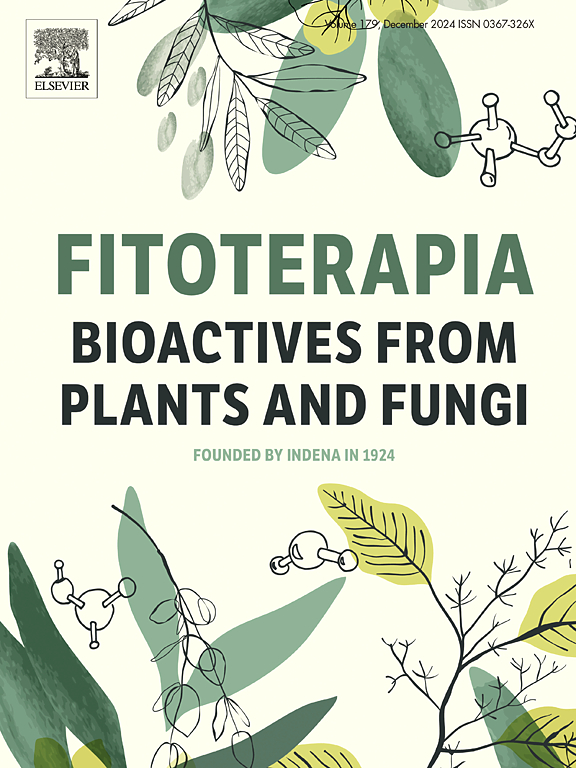阿兰妥内酯的植物化学、分析方法、药理活性、稳定性和规格。
IF 2.6
3区 医学
Q3 CHEMISTRY, MEDICINAL
引用次数: 0
摘要
阿兰托内酯是一种从菊科植物中提取的倍半萜内酯,因其多种药理潜力而被广泛研究。研究表明,alantolactone的生物活性与多种生化途径有关,如STAT3(单换能器和转录激活因子3)、MAPK/NF-κB(丝裂原活化蛋白激酶/ B细胞核因子κ轻链增强因子)和YAP1/TAZ (Yes-associated protein 1/转录共激活因子与pdz结合基序通路)的抗癌途径、促炎细胞因子NF-ΚB和STAT3的抗炎信号通路。Nrf2(核因子-红细胞2相关因子2)途径具有抗氧化作用,l型电压门控钙通道具有抗高血压作用,增强活性氧(ROS)的产生具有抗真菌特性,以及通过抑制IL-6(白细胞介素-6)刺激的TLR-4 (toll样受体)表达来改变脂质代谢的潜力。此外,阿兰妥内酯已被探索其杀虫,抗菌和抗病毒特性。本文综述了植物化学,包括化学框架,生物合成,分离和提取阿兰妥内酯的技术,合成转化,分析方面,通过体内和体外研究建立的治疗潜力的详细了解,生物利用度和生物可及性,毒性概况,以及阿兰妥内酯的专利景观。本文章由计算机程序翻译,如有差异,请以英文原文为准。

Insights to phytochemistry, analytical methods, pharmacological activities, stability, and specifications of alantolactone
Alantolactone, a sesquiterpene lactone derived from plants of the Asteraceae family, has been extensively studied for its diverse pharmacological potential. Research suggests that various biochemical pathways are involved in the bioactivity of alantolactone, such as STAT3 (Single transducer and activator of transcription 3), MAPK/NF-κB (Mitogen-activated protein kinases/ Nuclear factor kappa-light chain enchancerof B cells), and YAP1/TAZ (Yes-associated protein 1/Transcriptional co-activator with PDZ-binding motif pathway) pathways for anticancer, proinflammatory cytokines NF-ΚB and STAT3 signaling for anti-inflammatory, Nrf2 (Nuclear factor erythroid 2-related factor 2) pathway for antioxidant, L-type voltage-gated calcium channels for antihypertensive, enhanced reactive oxygen species (ROS) production for antifungal properties, and potential to alter lipid metabolism via suppression of IL-6 (Interleukin-6) stimulated TLR-4 (Toll-like receptor) expression. Additionally, alantolactone has been explored for its insecticidal, antibacterial, and antiviral properties. The review provides a comprehension on phytochemistry, including chemical framework, biosynthesis, techniques for isolating and extracting alantolactone, synthetic transformations, analytical aspects, a detailed understanding of the therapeutic potential established through in vivo and in vitro studies, bioavailability and bio-accessibility, toxicity profile, and the patent landscape on alantolactone.
求助全文
通过发布文献求助,成功后即可免费获取论文全文。
去求助
来源期刊

Fitoterapia
医学-药学
CiteScore
5.80
自引率
2.90%
发文量
198
审稿时长
1.5 months
期刊介绍:
Fitoterapia is a Journal dedicated to medicinal plants and to bioactive natural products of plant origin. It publishes original contributions in seven major areas:
1. Characterization of active ingredients of medicinal plants
2. Development of standardization method for bioactive plant extracts and natural products
3. Identification of bioactivity in plant extracts
4. Identification of targets and mechanism of activity of plant extracts
5. Production and genomic characterization of medicinal plants biomass
6. Chemistry and biochemistry of bioactive natural products of plant origin
7. Critical reviews of the historical, clinical and legal status of medicinal plants, and accounts on topical issues.
 求助内容:
求助内容: 应助结果提醒方式:
应助结果提醒方式:


